A Multilevel Switched Capacitor Inverter with Reduced Components and Self-Balance
Abstract
:1. Introduction
- (1)
- The proposed multilevel inverter can acquire six-fold voltage gain with a reduced number of components;
- (2)
- Only twelve transistors are employed and there are five complementary switch pairs, which simplifies the control strategy;
- (3)
- The capacitor voltage is self-balancing without the need for extra loops;
- (4)
- The proposed SCMLI is capable of extending to acquire more voltage levels and a higher boost factor;
- (5)
- A low-value cost function (CF) can be obtained in the topology.
2. Design of Proposed SCMLI
2.1. Topology
2.2. Operating Mode
2.3. Modulation Strategy
2.4. Capacitor Analysis
3. Power Losses Analysis
3.1. Switching Losses
3.2. Conduction Losses
3.3. Ripple Losses
4. Topology Extension and Comparison
4.1. Topology Extension
4.2. Comparison Analysis
5. Simulation and Experimental Analysis
5.1. Simulations
5.2. Experimental Result
6. Conclusions
Author Contributions
Funding
Institutional Review Board Statement
Informed Consent Statement
Data Availability Statement
Conflicts of Interest
References
- Abu-Rub, H.; Holtz, J.; Rodriguez, J.; Baoming, G. Medium-Voltage Multilevel Converters—State of the Art, Challenges, and Requirements in Industrial Applications. IEEE Trans. Ind. Electron. 2010, 57, 2581–2596. [Google Scholar] [CrossRef]
- Sheir, A.; Youssef, M.Z.; Orabi, M. A Novel Bidirectional T-Type Multilevel Inverter for Electric Vehicle Applications. IEEE Trans. Power Electron. 2019, 34, 6648–6658. [Google Scholar] [CrossRef]
- Edpuganti, A.; Rathore, A.K. A Survey of Low Switching Frequency Modulation Techniques for Medium-Voltage Multilevel Converters. IEEE Trans. Ind. Appl. 2015, 51, 4212–4228. [Google Scholar] [CrossRef]
- Gupta, K.K.; Ranjan, A.; Bhatnagar, P.; Sahu, L.K.; Jain, S. Multilevel Inverter Topologies With Reduced Device Count: A Review. IEEE Trans. Power Electron. 2016, 31, 135–151. [Google Scholar] [CrossRef]
- Kouro, S.; Malinowski, M.; Gopakumar, K.; Pou, J.; Franquelo, L.G.; Wu, B.; Rodriguez, J.; Pérez, M.A.; Leon, J.I. Recent Advances and Industrial Applications of Multilevel Converters. IEEE Trans. Ind. Electron. 2010, 57, 2553–2580. [Google Scholar] [CrossRef]
- Lin, W.; Zeng, J.; Hu, J.; Liu, J. Hybrid Nine-Level Boost Inverter With Simplified Control and Reduced Active Devices. IEEE J. Emerg. Sel. Top. Power Electron. 2021, 9, 2038–2050. [Google Scholar] [CrossRef]
- Ye, M.; Peng, R.; Tong, Z.; Chen, Z.; Miao, Z. A Generalized Scheme With Linear Power Balance and Uniform Switching Loss for Asymmetric Cascaded H-Bridge Multilevel Inverters. IEEE Trans. Power Electron. 2022, 37, 2719–2730. [Google Scholar] [CrossRef]
- He, L.; Sun, J.; Lin, Z.; Cheng, B. Capacitor-Voltage Self-Balance Seven-Level Inverter With Unequal Amplitude Carrier-Based APODPWM. IEEE Trans. Power Electron. 2021, 36, 14002–14013. [Google Scholar] [CrossRef]
- Lee, S.S.; Lim, C.S.; Siwakoti, Y.P.; Lee, K.-B. Dual-T-Type Five-Level Cascaded Multilevel Inverter With Double Voltage Boosting Gain. IEEE Trans. Power Electron. 2020, 35, 9522–9529. [Google Scholar] [CrossRef]
- Siddique, M.D.; Mekhilef, S.; Sarwar, A.; Alam, A.; Mohamed Shah, N. Dual Asymmetrical dc Voltage Source Based Switched Capacitor Boost Multilevel Inverter Topology. IET Power Electron. 2020, 13, 1481–1486. [Google Scholar] [CrossRef]
- Samadaei, E.; Kaviani, M.; Bertilsson, K. A 13-Levels Module (K-Type) With Two DC Sources for Multilevel Inverters. IEEE Trans. Ind. Electron. 2019, 66, 5186–5196. [Google Scholar] [CrossRef]
- Barzegarkhoo, R.; Moradzadeh, M.; Zamiri, E.; Madadi Kojabadi, H.; Blaabjerg, F. A New Boost Switched-Capacitor Multilevel Converter With Reduced Circuit Devices. IEEE Trans. Power Electron. 2018, 33, 6738–6754. [Google Scholar] [CrossRef]
- Fong, Y.C.; Raman, S.R.; Ye, Y.; Cheng, K.W.E. Generalized Topology of a Hybrid Switched- Capacitor Multilevel Inverter for High- Frequency AC Power Distribution. IEEE J. Emerg. Sel. Top. Power Electron. 2020, 8, 2886–2897. [Google Scholar] [CrossRef]
- Rawa, M.; Siddique, M.D.; Mekhilef, S.; Mohamed Shah, N.; Bassi, H.; Seyedmahmoudian, M.; Horan, B.; Stojcevski, A. Dual Input Switched-Capacitor-Based Single-Phase Hybrid Boost Multilevel Inverter Topology With Reduced Number of Components. IET Power Electron. 2020, 13, 881–891. [Google Scholar] [CrossRef]
- Peng, W.; Ni, Q.; Qiu, X.; Ye, Y. Seven-Level Inverter With Self-Balanced Switched-Capacitor and Its Cascaded Extension. IEEE Trans. Power Electron. 2019, 34, 11889–11896. [Google Scholar] [CrossRef]
- Roy, T.; Sadhu, P.K. A Step-Up Multilevel Inverter Topology Using Novel Switched Capacitor Converters With Reduced Components. IEEE Trans. Ind. Electron. 2021, 68, 236–247. [Google Scholar] [CrossRef]
- Hinago, Y.; Koizumi, H. A Switched-Capacitor Inverter Using Series/Parallel Conversion With Inductive Load. IEEE Trans. Ind. Electron. 2012, 59, 878–887. [Google Scholar] [CrossRef]
- Ye, Y.; Cheng, K.W.E.; Liu, J.; Ding, K. A Step-Up Switched-Capacitor Multilevel Inverter With Self-Voltage Balancing. IEEE Trans. Ind. Electron. 2014, 61, 6672–6680. [Google Scholar] [CrossRef]
- Zeng, J.; Lin, W.; Cen, D.; Liu, J. Novel K-Type Multilevel Inverter With Reduced Components and Self-Balance. IEEE J. Emerg. Sel. Top. Power Electron. 2020, 8, 4343–4354. [Google Scholar] [CrossRef]
- Panda, K.P.; Bana, P.R.; Panda, G. A Reduced Device Count Single DC Hybrid Switched-Capacitor Self-Balanced Inverter. IEEE Trans. Circuits Syst. II Exp. Briefs. 2021, 68, 978–982. [Google Scholar] [CrossRef]
- Lin, W.; Zeng, J.; Liu, J.; Yan, Z.; Hu, R. Generalized Symmetrical Step-Up Multilevel Inverter Using Crisscross Capacitor Units. IEEE Trans. Ind. Electron. 2020, 67, 7439–7450. [Google Scholar] [CrossRef]
- Bhatnagar, P.; Singh, A.K.; Gupta, K.K.; Siwakoti, Y.P. A Switched-Capacitors-Based 13-Level Inverter. IEEE Trans. Power Electron. 2022, 37, 644–658. [Google Scholar] [CrossRef]
- Taghvaie, A.; Adabi, J.; Rezanejad, M. A Self-Balanced Step-Up Multilevel Inverter Based on Switched-Capacitor Structure. IEEE Trans. Power Electron. 2018, 33, 199–209. [Google Scholar] [CrossRef]
- Panda, K.P.; Bana, P.R.; Panda, G. A Switched-Capacitor Self-Balanced High-Gain Multilevel Inverter Employing a Single DC Source. IEEE Trans. Circuits Syst. II Exp. Briefs. 2020, 67, 3192–3196. [Google Scholar] [CrossRef]
- Kim, K.-M.; Han, J.-K.; Moon, G.-W. A High Step-Up Switched-Capacitor 13-Level Inverter With Reduced Number of Switches. IEEE Trans. Power Electron. 2021, 36, 2505–2509. [Google Scholar] [CrossRef]
- Anand, V.; Singh, V. A 13-Level Switched-Capacitor Multilevel Inverter With Single DC Source. IEEE J. Emerg. Sel. Top. Power Electron. 2022, 10, 1575–1586. [Google Scholar] [CrossRef]
- Ye, Y.; Zhang, G.; Wang, X.; Yi, Y.; Cheng, K.W.E. Self-Balanced Switched-Capacitor Thirteen-Level Inverters With Reduced Capacitors Count. IEEE Trans. Ind. Electron. 2022, 69, 1070–1076. [Google Scholar] [CrossRef]
- Ye, Y.; Chen, S.; Wang, X.; Cheng, K.W.E. Self-Balanced 13-Level Inverter Based on Switched Capacitor and Hybrid PWM Algorithm. IEEE Trans. Ind. Electron. 2021, 68, 4827–4837. [Google Scholar] [CrossRef]
- Sandeep, N. A 13-Level Switched-Capacitor-Based Boosting Inverter. IEEE Trans. Circuits Syst. II Exp. Briefs. 2021, 68, 998–1002. [Google Scholar] [CrossRef]
- Yadav, S.K.; Mishra, N.; Singh, B. Multilevel Converter With Nearest Level Control for Integrating Solar Photovoltaic System. IEEE Trans. Ind. Appl. 2022, 58, 5117–5126. [Google Scholar] [CrossRef]
- Siddique, M.D.; Mekhilef, S.; Padmanaban, S.; Memon, M.A.; Kumar, C. Single-Phase Step-Up Switched-Capacitor-Based Multilevel Inverter Topology With SHEPWM. IEEE Trans. Ind. Appl. 2021, 57, 3107–3119. [Google Scholar] [CrossRef]


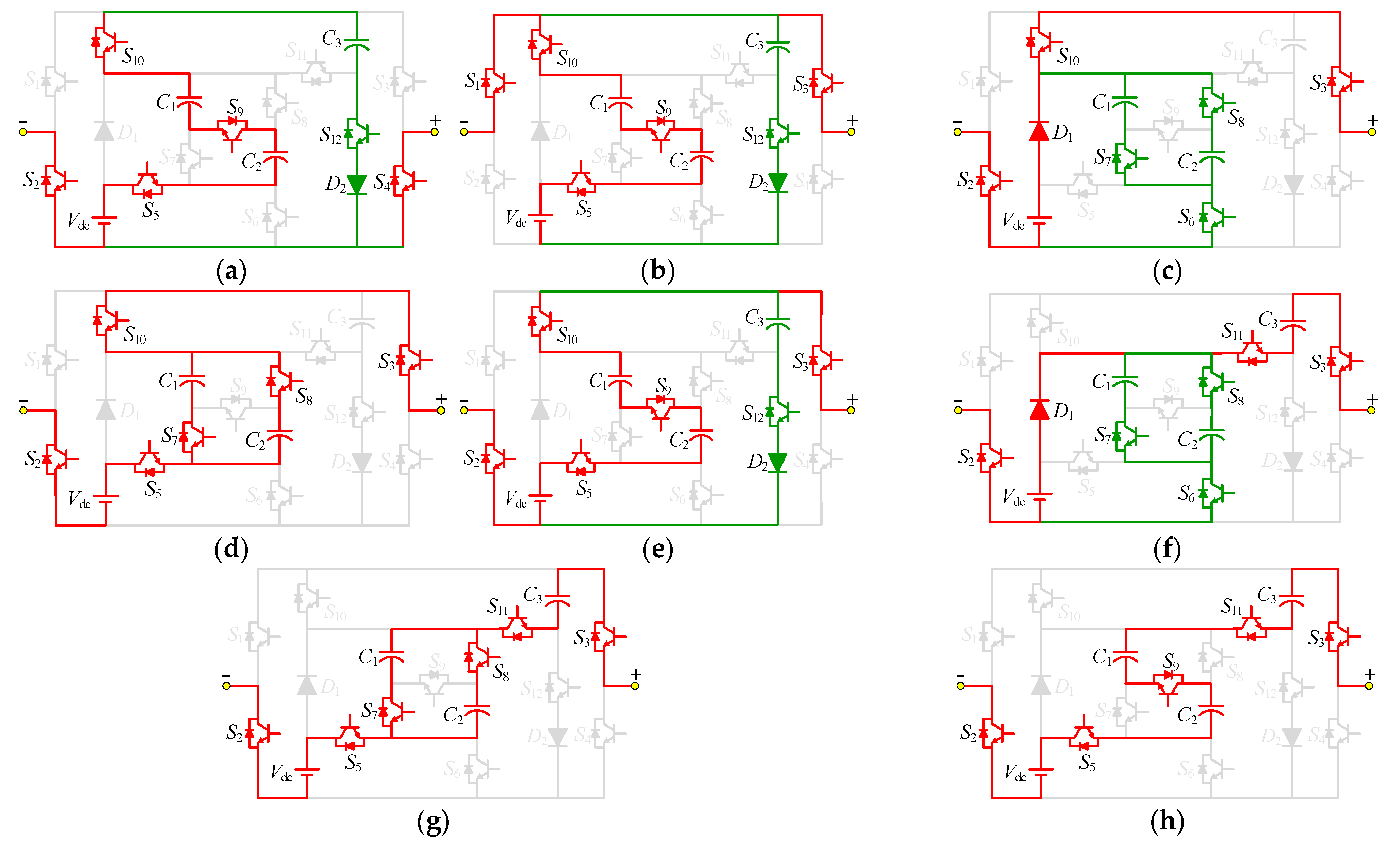




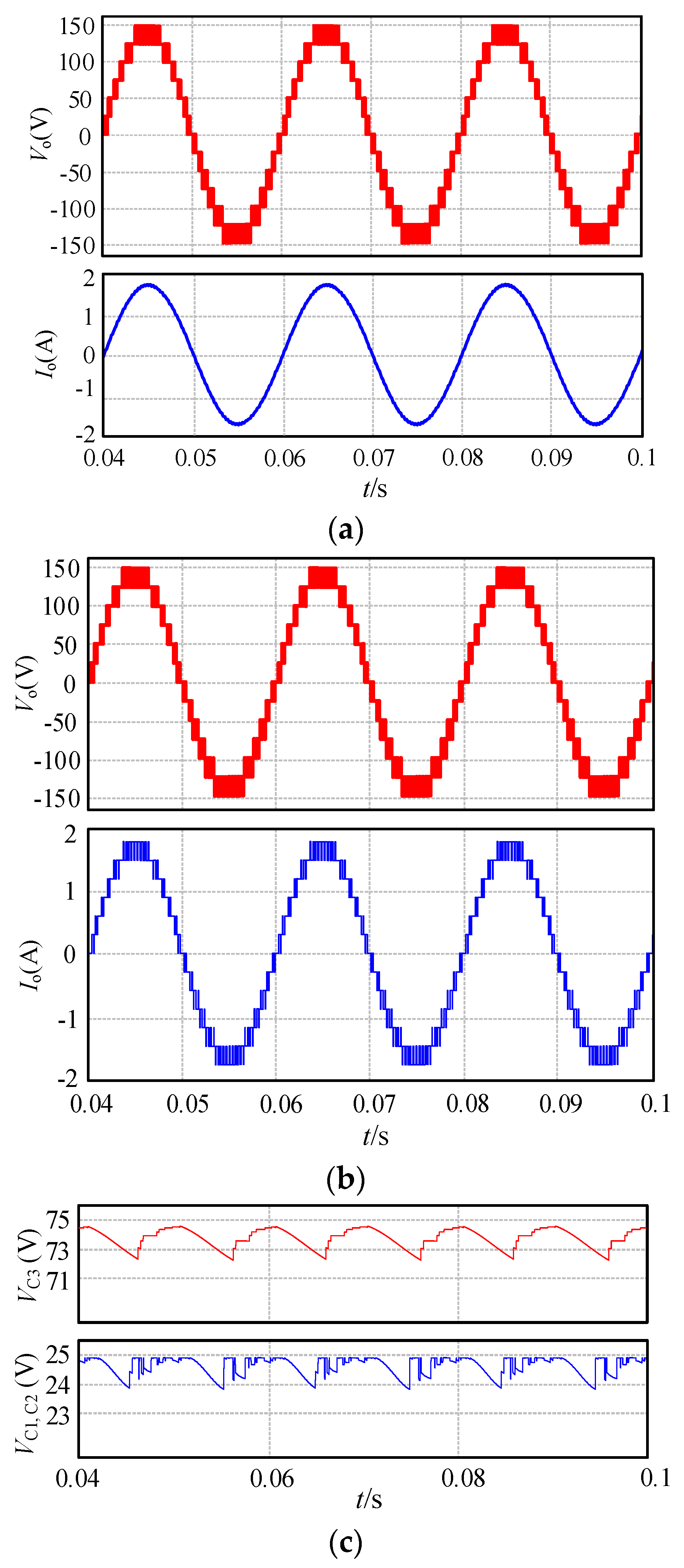



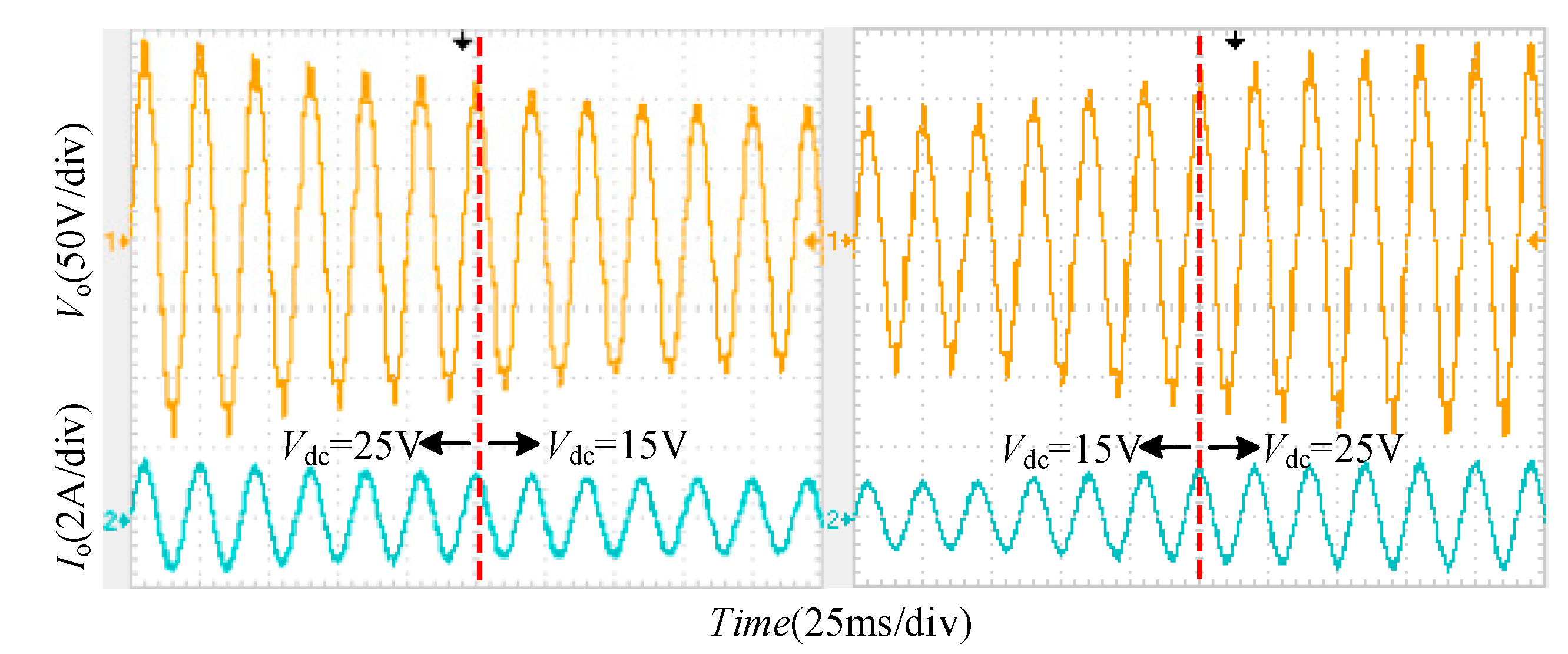
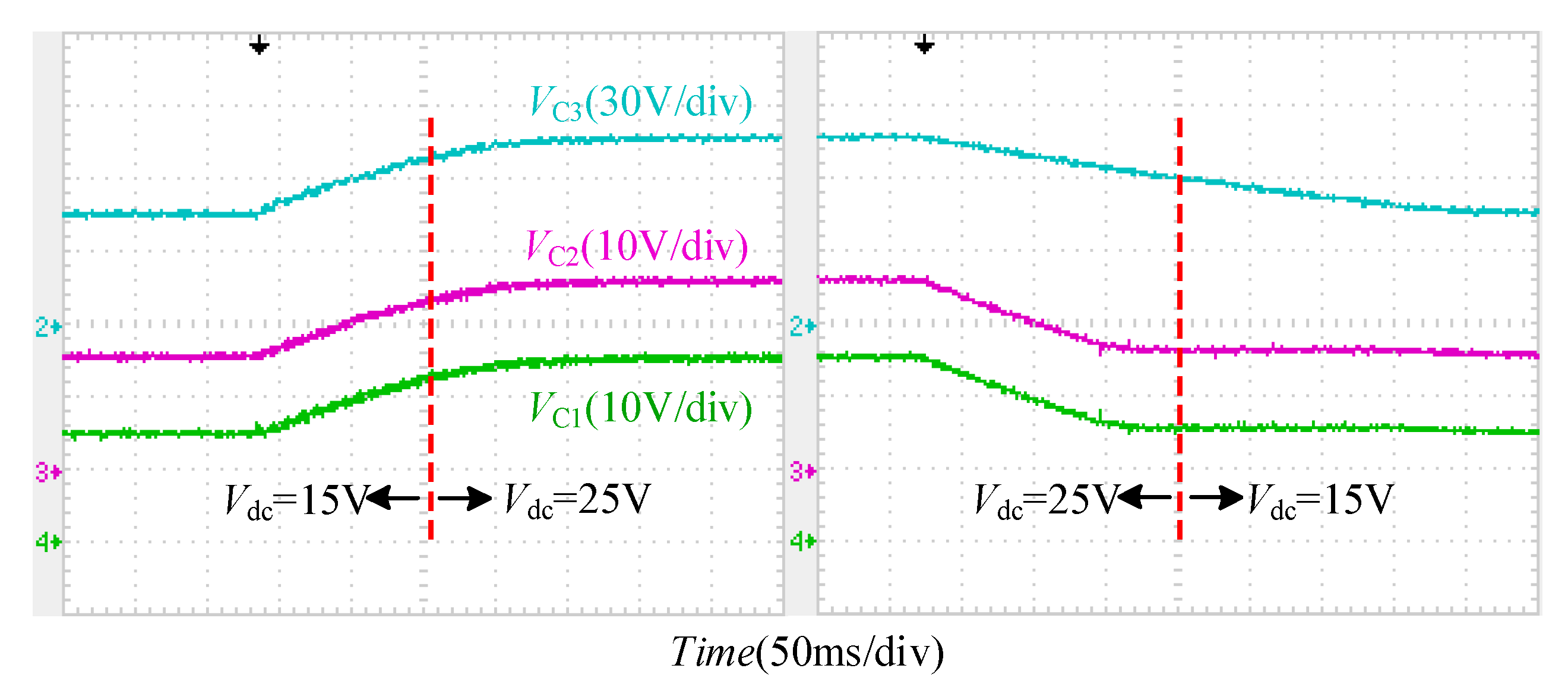
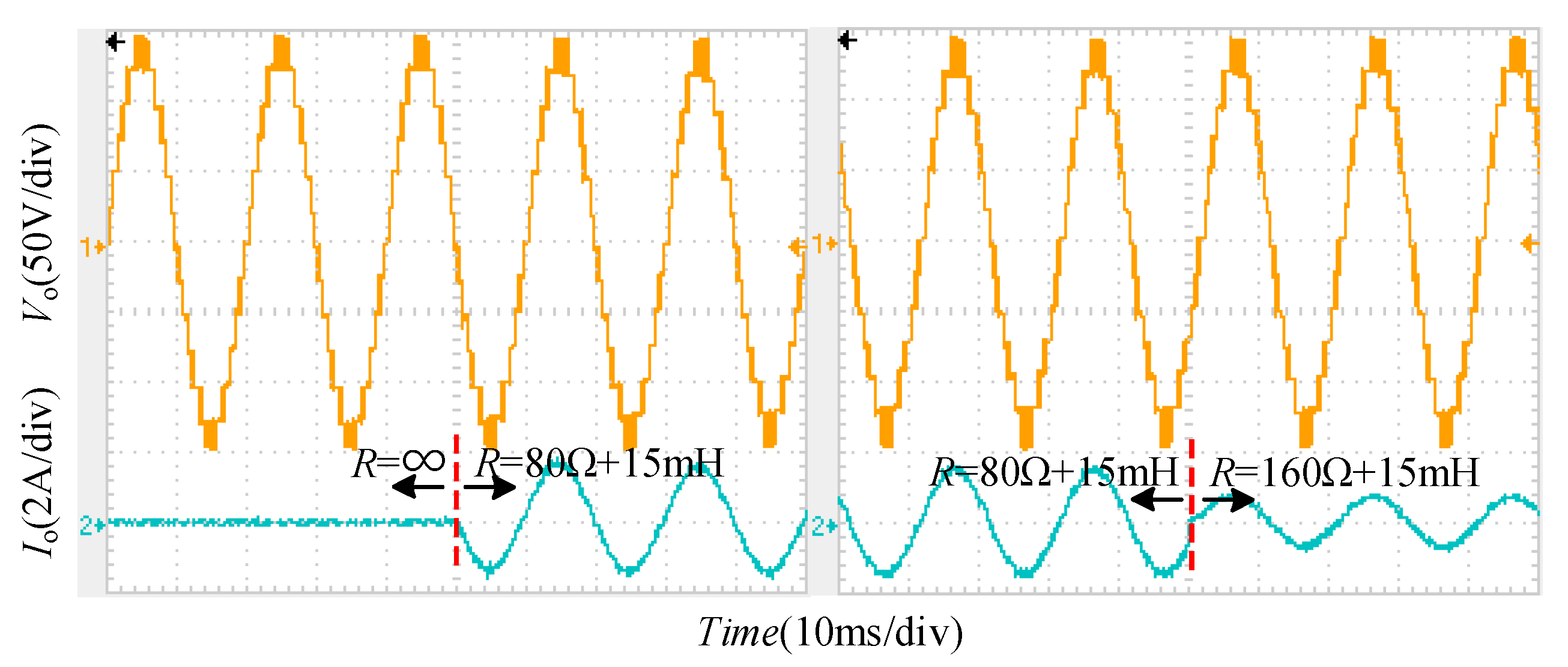
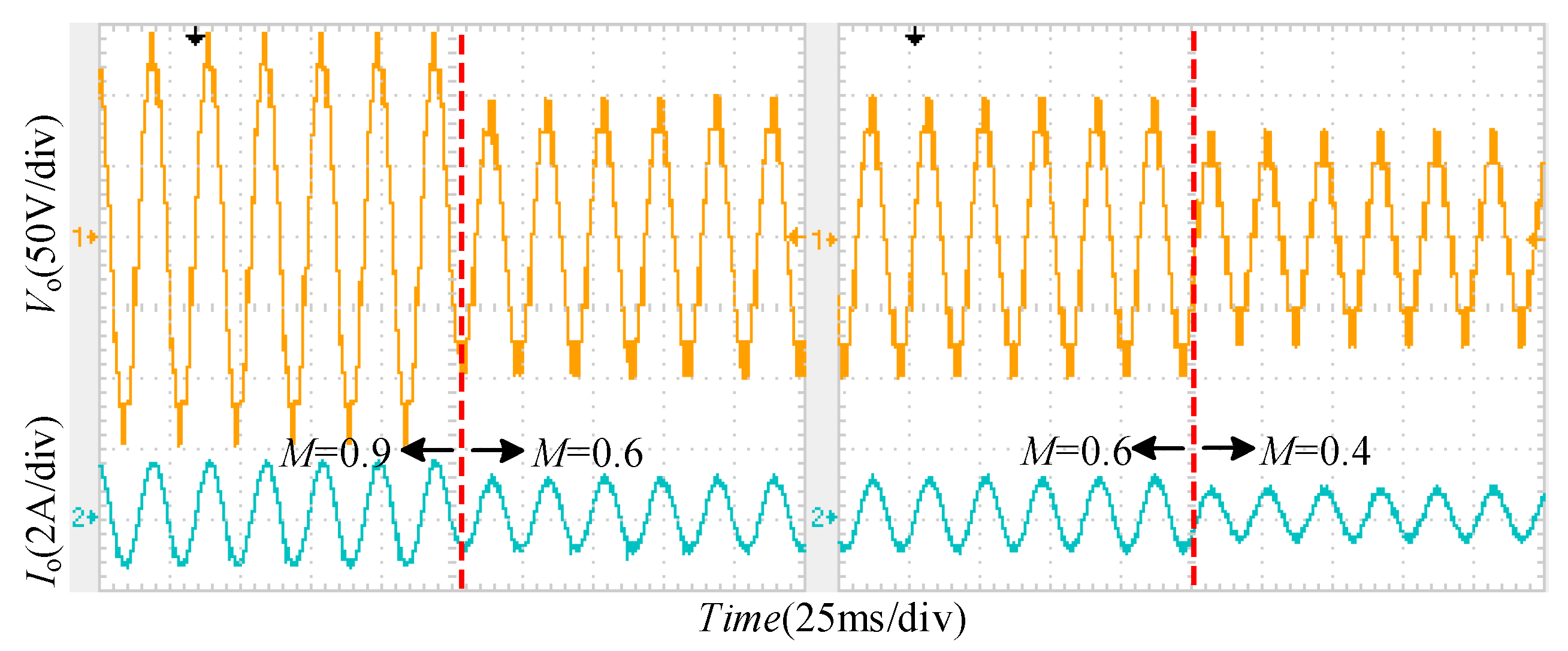
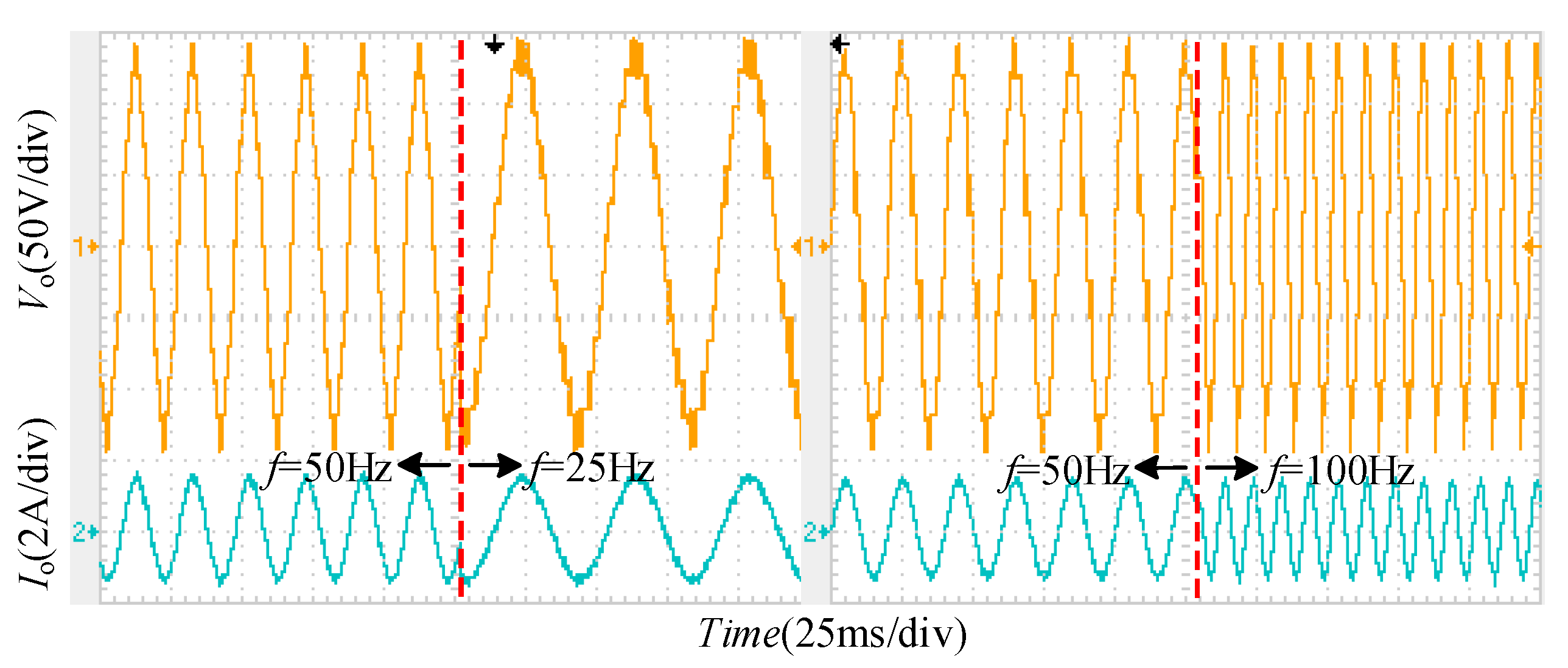
| Modes | Output Voltage | Switches | Capacitors | |||||||
|---|---|---|---|---|---|---|---|---|---|---|
| S1,2 | S3,4 | S5,6 | S7/8,9 | S10,11 | S12 | C1 | C2 | C3 | ||
| 1 | +6 Vdc | 01 | 10 | 10 | 01 | 01 | 0 | D | D | D |
| 2 | +5 Vdc | 01 | 10 | 10 | 10 | 01 | 0 | D | D | D |
| 3 | +4 Vdc | 01 | 10 | 01 | 10 | 01 | 0 | C | C | D |
| 4 | +3 Vdc | 01 | 10 | 10 | 01 | 10 | 1 | D | D | C |
| 5 | +2 Vdc | 01 | 10 | 10 | 10 | 10 | 0 | D | D | – |
| 6 | +Vdc | 01 | 10 | 01 | 10 | 10 | 0 | C | C | – |
| 7 | 0 | 01 | 01 | 10 | 01 | 10 | 1 | D | D | C |
| 8 | 10 | 10 | 10 | 01 | 10 | 1 | D | D | C | |
| 9 | −Vdc | 10 | 01 | 01 | 10 | 10 | 0 | C | C | – |
| 10 | −2 Vdc | 10 | 01 | 10 | 10 | 10 | 0 | D | D | – |
| 11 | −3 Vdc | 10 | 01 | 10 | 01 | 10 | 1 | D | D | C |
| 12 | −4 Vdc | 10 | 01 | 01 | 10 | 01 | 0 | C | C | D |
| 13 | −5 Vdc | 10 | 01 | 10 | 10 | 01 | 0 | D | D | D |
| 14 | −6 Vdc | 10 | 01 | 10 | 01 | 01 | 0 | D | D | D |
| M | Number of Levels | Output Voltage Levels |
|---|---|---|
| 0 < M ≤ 1/6 | 3 | ±Vdc, 0 |
| 1/6 < M ≤ 1/3 | 5 | ±2 Vdc, ±Vdc, 0 |
| 1/3 < M ≤ 1/2 | 7 | ±3 Vdc, ±2 Vdc, ±Vdc, 0 |
| 1/2 < M ≤ 2/3 | 9 | ±4 Vdc, ±3 Vdc, ±2 Vdc, ±Vdc, 0 |
| 2/3 < M ≤ 5/6 | 11 | ±5 Vdc, ±4 Vdc, ±3 Vdc, ±2 Vdc, ±Vdc, 0 |
| 5/6 < M ≤ 1 | 13 | ±6 Vdc, ±5 Vdc, ±4 Vdc, ±3 Vdc, ±2 Vdc, ±Vdc, 0 |
| j | Vo, j | Req, j |
|---|---|---|
| 0 | 0 | Rs + Rd |
| 1 | ±Vdc | 2 Rs + 2 Rd |
| 2 | ±2 Vdc | 3 Rs + 3 Rd/2 + ESRC/2 |
| 3 | ±3 Vdc | 4 Rs + Rd + 2 ESRC |
| 4 | ±4 Vdc | 3 Rs + Rd + ESRC |
| 5 | ±5 Vdc | 4 Rs + Rd/2 + 3 ESRC/2 |
| 6 | ±6 Vdc | 5 Rs + 3 ESRC |
| Reference | Ndc | Nswitch | Ndriver | Ndiode | Ncapacitor | G | TSV | CF | Extensibility | |
|---|---|---|---|---|---|---|---|---|---|---|
| α = 0.5 | α = 1.5 | |||||||||
| [10] | 2 | 11 | 7 | 1 | 1 | 2 | 39 | 4.577 | 7.577 | No |
| [11] | 2 | 14 | 11 | 0 | 2 | 2 | 32 | 5.384 | 7.846 | No |
| [16] | 2 | 14 | 14 | 2 | 4 | 3 | 34 | 6.103 | 7.846 | Yes |
| [18] | 1 | 10 | 8 | 10 | 5 | 6 | 43 | 2.814 | 3.365 | Yes |
| [19] | 1 | 12 | 8 | 2 | 4 | 1.5 | 15 | 2.385 | 3.154 | Yes |
| [20] | 1 | 12 | 7 | 4 | 4 | 3 | 13 | 2.243 | 2.577 | No |
| [21] | 1 | 14 | 13 | 2 | 4 | 3 | 18 | 2.769 | 3.230 | Yes |
| [22] | 1 | 13 | 11 | 1 | 3 | 3 | 17 | 2.372 | 2.808 | Yes |
| [23] | 1 | 29 | 29 | 5 | 5 | 6 | 29 | 5.416 | 5.788 | Yes |
| [24] | 1 | 13 | 9 | 2 | 3 | 6 | 39 | 2.327 | 2.827 | No |
| [25] | 1 | 14 | 10 | 1 | 3 | 6 | 33 | 2.365 | 2.788 | No |
| [26] | 1 | 15 | 12 | 0 | 3 | 6 | 35 | 2.532 | 2.981 | No |
| [27] | 1 | 12 | 6 | 4 | 3 | 6 | 36 | 2.154 | 2.615 | No |
| [29] | 1 | 13 | 9 | 2 | 3 | 6 | 32 | 2.282 | 2.692 | No |
| Proposed | 1 | 12 | 6 | 2 | 3 | 6 | 38 | 2.013 | 2.500 | Yes |
| Parameters | Values |
|---|---|
| Input voltage (Vdc) | 25 V |
| Output frequency (fo) | 50 Hz |
| Triangle carrier frequency | 3 kHz |
| Capacitors C1/C2/C3 | 2200 μF |
| Modulation index (M) | 0.9 |
| Load | 80 Ω/80 Ω + 15 mH |
| Components | Specifications |
|---|---|
| Input voltage (Vdc) | 25 V |
| Output frequency (fo) | 50 Hz/25 Hz/100 Hz |
| Carrier frequency | 3 kHz |
| Capacitors C1/C2/C3 | 2200 μF |
| Resistive-inductive load | 80/160 Ω + 15 mH |
| Switches (S1~S12) | SPP20N60C3 |
| Diode | MBR20200CTG |
| Optocouplers | TLP250 |
| Current probe | Tektronix A622 |
Disclaimer/Publisher’s Note: The statements, opinions and data contained in all publications are solely those of the individual author(s) and contributor(s) and not of MDPI and/or the editor(s). MDPI and/or the editor(s) disclaim responsibility for any injury to people or property resulting from any ideas, methods, instructions or products referred to in the content. |
© 2023 by the authors. Licensee MDPI, Basel, Switzerland. This article is an open access article distributed under the terms and conditions of the Creative Commons Attribution (CC BY) license (https://creativecommons.org/licenses/by/4.0/).
Share and Cite
Deng, Z.; Zhu, X.; Duan, J.; Ye, J.; Wang, Y. A Multilevel Switched Capacitor Inverter with Reduced Components and Self-Balance. Appl. Sci. 2023, 13, 8955. https://doi.org/10.3390/app13158955
Deng Z, Zhu X, Duan J, Ye J, Wang Y. A Multilevel Switched Capacitor Inverter with Reduced Components and Self-Balance. Applied Sciences. 2023; 13(15):8955. https://doi.org/10.3390/app13158955
Chicago/Turabian StyleDeng, Zhengdong, Xiaoli Zhu, Junpeng Duan, Juncheng Ye, and Yaoqiang Wang. 2023. "A Multilevel Switched Capacitor Inverter with Reduced Components and Self-Balance" Applied Sciences 13, no. 15: 8955. https://doi.org/10.3390/app13158955
APA StyleDeng, Z., Zhu, X., Duan, J., Ye, J., & Wang, Y. (2023). A Multilevel Switched Capacitor Inverter with Reduced Components and Self-Balance. Applied Sciences, 13(15), 8955. https://doi.org/10.3390/app13158955






